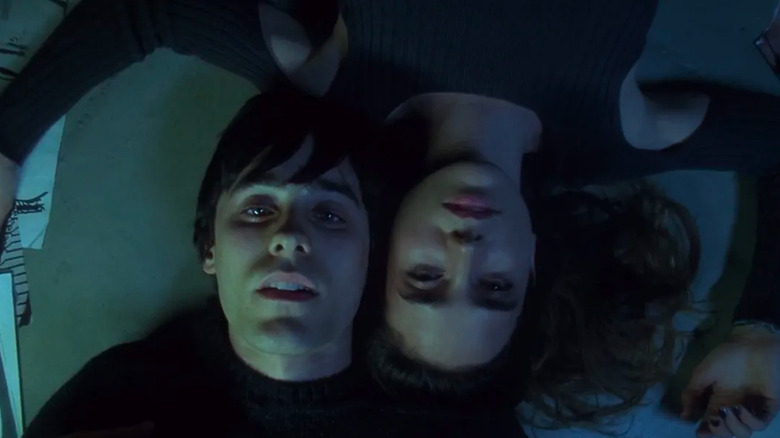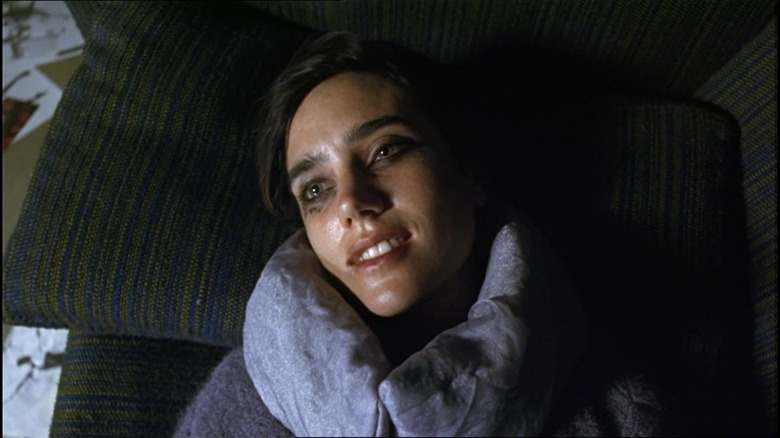Darren Aronofsky Wanted Requiem For A Dream's Love Scene To Be Unlike Anything Before It
Darren Aronofsky's "Requiem for a Dream" is one of the most visceral movies of all time. The film sucks the viewer into the characters' experiences with spine-tingling, gut-wrenching sensory overload. The film simulates some of the most over-stimulating feelings in the world — heroin, speed, grief, and orgasm.
The director uses split screens in "Requiem for a Dream" as a multi-faceted cinematic device. "At the beginning of the film, I have two main stories and I wanted to differentiate them because I wanted to show both of their subjective perspectives and experiences," Aronofsky revealed to Indiewire. The filmmaker is referring to Harry, a heroin addict, and his mother, a woman glued to her television set who gets hooked on prescription diet pills.
The split screens were useful for more than just following two characters at once. They could also be used to depict simultaneous sensory experiences. When Harry takes drugs, one frame shows the dilation of his pupil, another the draining of a loaded needle. These sensations are experienced simultaneously by the audience and character alike.
This device also came in handy during a tender scene between Harry and his girlfriend Marion. It was important to Aronofsky that when he showed a couple in bed, the scene would not follow the same repetitive patterns of other films. "When you see sex scenes in movies, they suck. It's a low-risk version of pornography," he explained. "And I needed to do a love scene and I wanted to do something that hadn't been done before, so I decided to do something that I was using stylistically elsewhere to help express the tenderness." The scene does just that — extreme close-up shots show fingers caressing flesh, lips grazing fingers, and the gaze in a lover's eye all at once.
And he used a split screen to do it
The split screens in "Requiem for a Dream" show multiple points of view and sensations at once, but this wasn't Aronofsky's only intention. He also used a split screen to depict the dissonance between Harry and Marion, even in their most intimate moment. "I thought about this; they're apart even though they are connecting and touching each other," he explained.
Even though it's a tender scene between lovers on the surface, Harry and Marion are never shown in the same frame, suggesting that they are in totally different worlds. They may enjoy touching each other, seeing each other, and feeling beautiful in the reflection of each other's eyes, but ultimately they are alien to one another. Like many addicts, their drug use leads them to lie to themselves and to each other.
"My last favorite sex scene was in 'The Player,' and that was sort of my goal: to make a sex scene that wasn't the same old s***," Aronofsky revealed. Director Robert Altman did not use a split screen, but he did use a very intimate scene to demonstrate just how disconnected the two lovers were — a man whispers a murder confession to a woman in the throes of sexual passion and she responds by saying she loves him. This tension is punctuated by the sound of crescendoing drum music.
Aronofsky took inspiration from a classic film and reinterpreted it in a totally unique and contemporary way. His use of the split screen was completely revolutionary and would go on to inspire films like Gaspar Noe's "Vortex." To successfully depict the subjective experience of multiple characters at once purely through cinematic devices is a powerful thing, and Aronofsky managed to accomplish it in his sophomore film — a truly major achievement.

